-
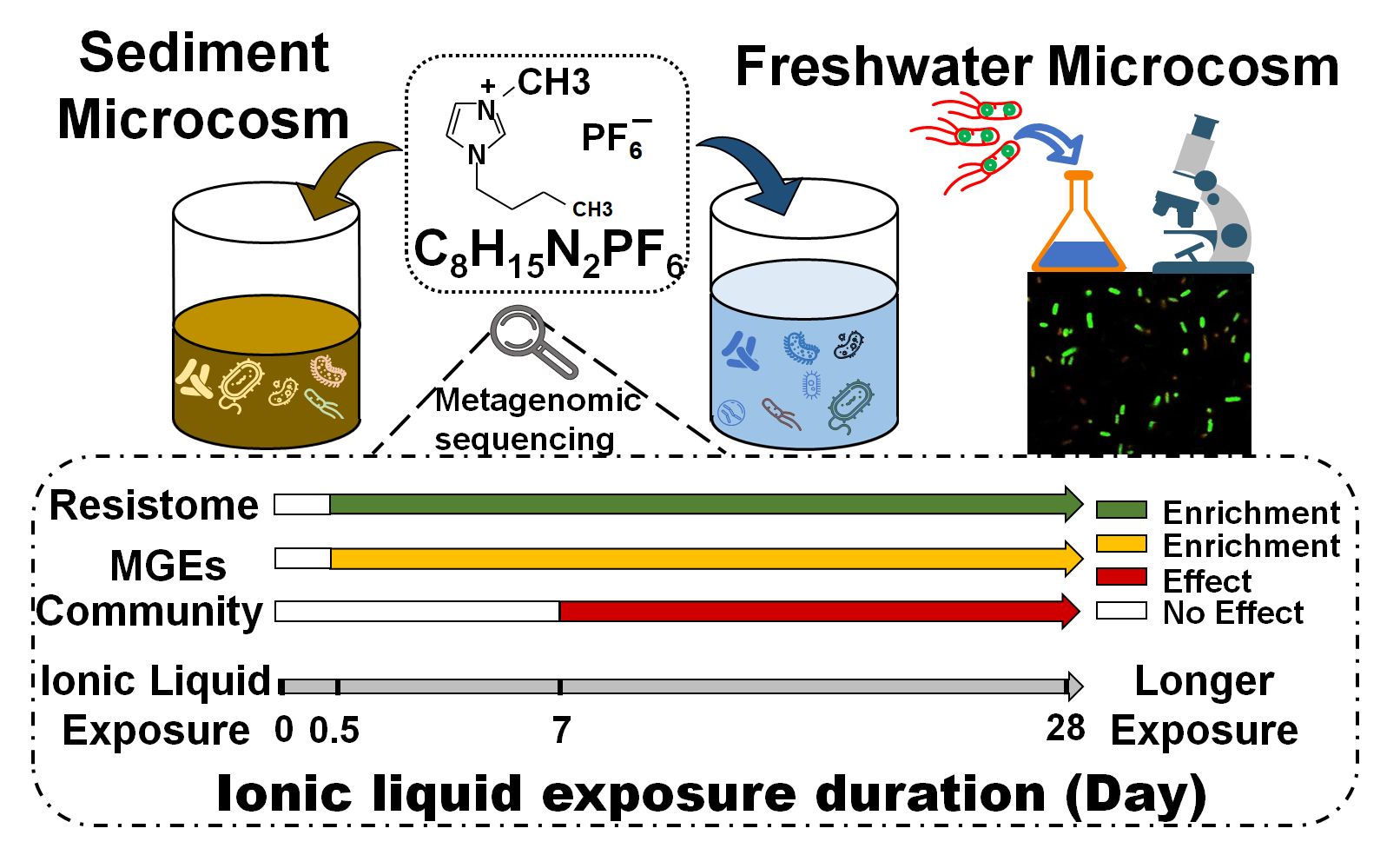
An expanding list of chemicals may permeabilize bacterial cells and facilitate horizontal gene transfer (HGT), which enhances propagation of antibiotic resistance genes (ARGs) in the environment. Previous studies showed that 1-butyl-3-methylimidazolium hexafluorophosphate ([BMIm][PF6]), an ionic liquid, can facilitate HGT of some ARGs among bacteria. However, the dynamic response of a wider range of ARGs and associated mobile genetic elements (MGEs) in different environments is unknown. Here, we used metagenomic tools to study shifts of the resistome and microbiome in both sediments and freshwater microcosms exposed to [BMIm][PF6]. Exposure for 16 h to 0.1 or 1.0 g/L significantly enriched more than 207 ARG subtypes primarily encoding efflux pumps in freshwater microcosms as well as cultivable antibiotic-resistant bacteria. This resistome enrichment was attributed to HGT facilitated by MGEs (428 plasmids, 61 integron-integrase genes, and 45 gene cassettes were enriched) as well as to HGT-related functional genes. Interestingly, resistome enrichment occurred fast (within 16 h) after [BMIm][PF6] exposure, before any significant changes in bacterial community structure. Similar ARG enrichment occurred in sediment microcosms exposed to [BMIm][PF6] for 28 d, and this longer exposure affected the microbial community structure (e.g., Proteobacteria abundance increased significantly). Overall, this study suggests that [BMIm][PF6] releases could rapidly enrich the antibiotic resistome in receiving environments by increasing HGT and fortuitously selecting for efflux pump genes, thus contributing to ARG propagation. (ES&T, 2020)
-
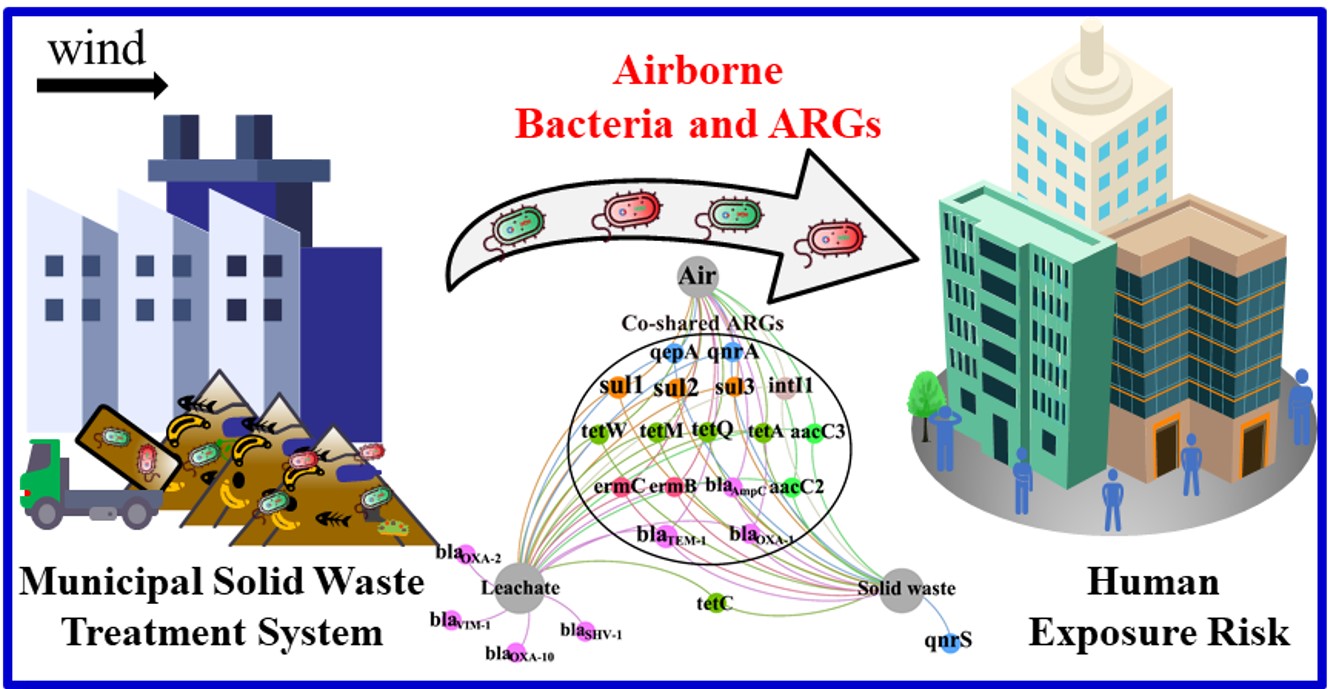
Landfill and incineration are the primary disposal practices for municipal solid waste (MSW) and have been considered as the critical reservoir of antibiotic resistance genes (ARGs). However, the possible transmission of ARGs from the municipal solid waste treatment system (MSWT system) to ambient air is still unclear. In this study, we collected inside and ambient air samples (PM10 and PM2.5) and potential source samples (leachate and solid waste) in the MSWT system. The results showed that the MSWT system contributed to the increased ambient airborne bacteria and associated ARGs. Forty-one antibiotic-resistant bacteria (ARB) harboring blaTEM-1 were isolated, and the full-length nucleotide sequences of the blaTEM-1 gene (harbored by identical bacillus) from air (downwind samples) were 100% identical with those in the leachate and solid waste, indicating that the MSWT system was the important source of disperse bacteria and associated ARGs in the ambient air. The daily intake (DI) burden level of ARGs via PM inhalation was comparable with that via ingestion of drinking water but lower than the DI level via ingestion of raw vegetables. The antibiotic-resistant opportunistic pathogen Bacillus cereus was isolated from air, with a relatively high DI level of Bacillus via inhalation (104–106 copies/day) in the MSWT system. This study highlights the key pathway of airborne ARGs to human exposure. (ES&T, 2020)
-
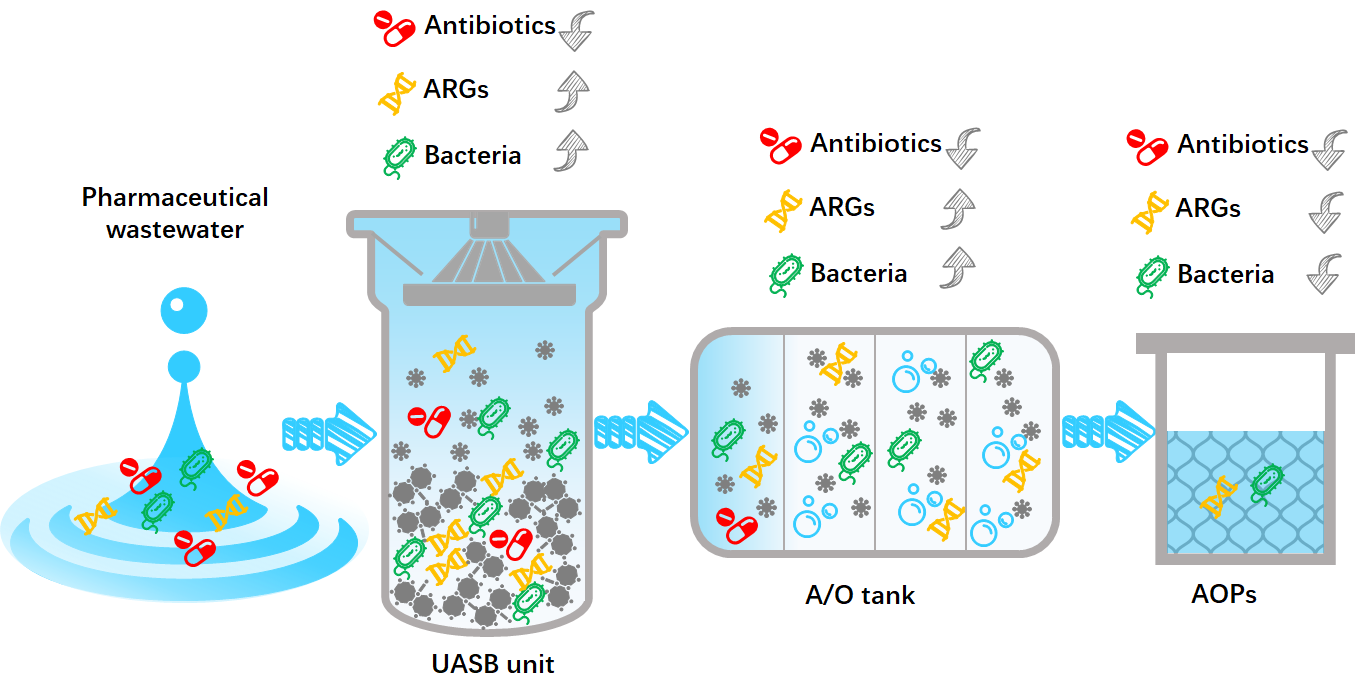
Pharmaceutical wastewater often contains high levels of antibiotic residues and serves as an important reservoir for antibiotic resistance genes (ARGs). However, the current pharmaceutical wastewater treatment plants (PWWTPs) were not sufficiently effective in removing antibiotics and ARGs. Here, we designed a lab-scale simulation reactor, including up-flow anaerobic sludge bed (UASB), anoxic-oxic tank (A/O), and four separate advanced oxidation processes (AOPs) i.e., UV, Ozonation, Fenton, and Fenton/UV, to simultaneously remove 18 antibiotics and 10 ARGs from a real pharmaceutical wastewater. The results showed that all antibiotics were fully eliminated through the reactor during 180 d-operation. Among all treatment units, UASB provided the greatest contribution (85.8 ± 16.1%) for the removal of 18 antibiotics. The mass balance results manifested that degradation was a predominant mechanism for the removal of tetracyclines, sulfamethoxazole, and ampicillin (62.5–80.9%), while sorption to sludge (73.9%) was predominant for enrofloxacin removal in UASB. Meanwhile, the substantial decrease of ARG absolute abundance (log reduction by 0.1–3.1 fold) through the whole reactor was observed although the existence of the partial enrichment (1.2–3.8 log units) from the influent to the A/O unit. Fenton/UV combination was the most effective AOP for the removal of ARGs. Finally, the optimum operating conditions for the removal of ARGs using Fenton was also proposed considering the relatively lower cost and high ARG elimination. Overall, this study provides feasible suggestions for the design of real PWWTPs for simultaneous removal of antibiotics and ARGs. (Water Res, 2019)
-
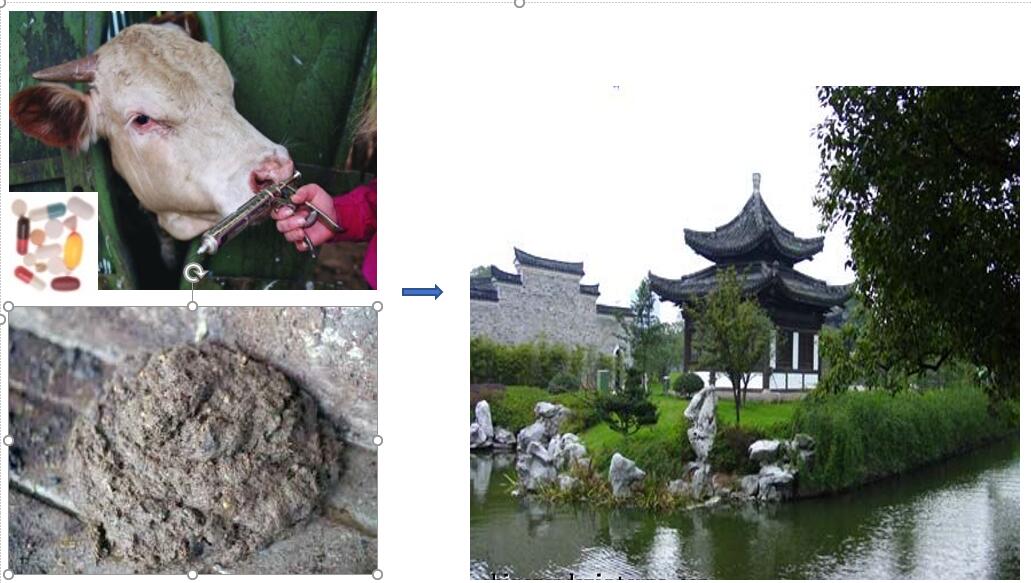
The occurrence of antibiotics and antibiotic resistance genes (ARGs) was quantified in water and sediment samples collected from a 72-km stretch of the Haihe River, China. Sulfachlororyridazine was detected in all swine farm and fishpond samples, which suggests its potential usefulness to indicate livestock source pollution in the Haihe River basin. River flow rate exerted the most significant effect on the first-order attenuation coefficient (K) for sulfonamides, quinolones and macrolides, with higher flow rate resulting in higher K probably due to dilution. For tetracyclines, sediment total organic matter and cation exchange capacity exerted a greater impact on K than flow rate, indicating that adsorption to sediments plays an important role in attenuating tetracyclines migration. This is the first regional study to report the presence of sul1 and sul2 genes as the predominant ARGs in regions where multiple antibiotic residues are present, and to provide direct field evidence of the selective pressure of antibiotic residues on the associated ARGs. (ES&T, 2010, 2011)
-
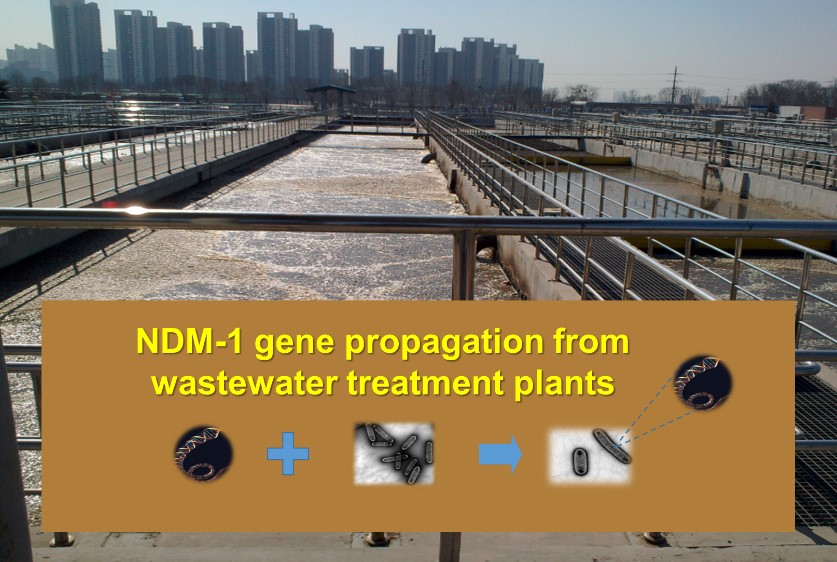
The New Delhi metallo-β-lactamase (NDM-1) increases bacterial resistance to a broad range of antibiotics, and bacteria that produce it can cause infections that are very difficult to treat, thus posing great risks to human health. This paper addresses the occurrence of NDM-1 genes though different processes in wastewater treatment plants (WWTPs). NDM-1 genes prevailed through several treatment units (including disinfection by chlorination) in two WWTPs in Northern China. Significant NDM-1 gene levels were present in the effluent discharged from both WWTPs. This is the first report of the occurrence, persistence and fate of NDM-1 genes through different processes in wastewater treatment plants (WWTPs). The discharge of NDM-1 genes in the effluent plus dewatered waste sludge from WWTPs underscores the need to better understand and mitigate their proliferation and propagation from WWTPs. (ES&T Lett, 2014).
-
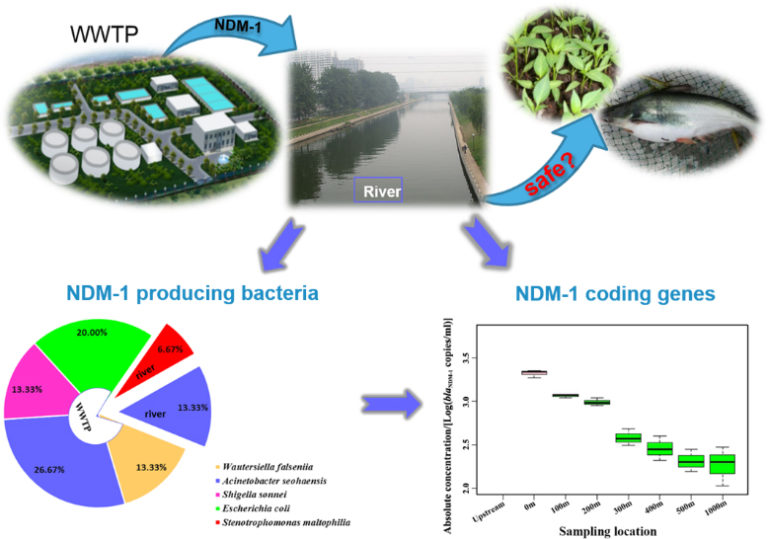
The emergence and spread of NDM-1 (New Delhi metallo-β-lactamase-1) is of a great concern to public health. Based on our previous study which reported the occurrence and persistence of NDM-1 genes through various processes in wastewater treatment plants, the blaNDM-1 gene and its host bacteria were investigated to study the occurrence and fate of blaNDM-1 genes in a receiving river following WWTP discharges. The quantification of blaNDM-1 genes and blaNDM-1 sequencing analysis of representative strains demonstrated that the occurrence of blaNDM-1 genes in receiving river is derived from the WWTP. The propagation of NDM-1 genes from WWTP effluent into receiving river underscores the needs not only to mitigate their proliferation from WWTPs, but also pay more attention to the pathway of their transportation to the receiving environment so as to alleviate their dissemination worldwide. (ES&T Lett, 2016)
-
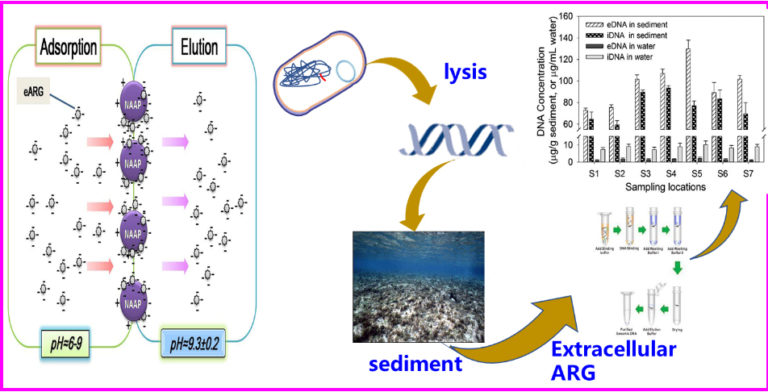
The propagation of antibiotic resistance genes (ARGs) represents a global threat to both human health and food security. Assessment of ARG reservoirs and persistence is therefore critical for devising and evaluating strategies to mitigate ARG propagation. This study developed a novel, internal standard method to extract extracellular DNA (eDNA) and intracellular DNA (iDNA) from water and sediments, and applied it to determine the partitioning of ARGs in the Haihe River basin in China, which drains an area of intensive antibiotic use. Overall, this study shows that extracellular DNA in sediment is a major ARG reservoir that could facilitate antibiotic resistance propagation. (ES&T, 2014)
-
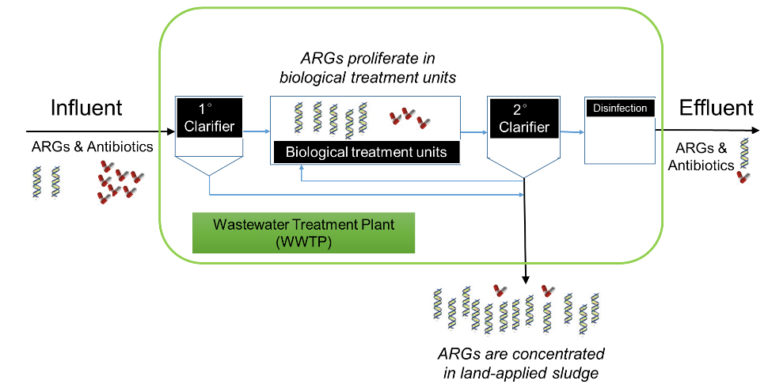
The propagation of antibiotic resistance genes (ARGs) is an emerging health concern worldwide. Thus, it is important to understand and mitigate their occurrence in different systems. In this study, 30 ARGs that confer resistance to tetracyclines, sulfonamides, quinolones or macrolides were detected in two activated sludge wastewater treatment plants in northern China. We found that Bacteria harboring ARGs persisted through all treatment units, and survived disinfection by chlorination in greater percentages than total Bacteria. Twelve ARGs (tetA, tetB, tetE, tetG, tetH, tetS, tetT, tetX, sul1, sul2, qnrB, ermC) were discharged through the dewatered sludge and plant effluent at higher rates than influent values, indicating overall proliferation of resistant bacteria. Significant antibiotic concentrations (2% to 50% of raw influent concentrations) remained throughout all treatment units. This apparently contributed selective pressure for ARG replication since the relative abundance of resistant bacteria was significantly correlated to the corresponding effluent antibiotic concentrations. Similarly, the concentrations of various heavy metals were also correlated to the enrichment of some ARGs. Thus, curtailing the release of antibiotics and heavy metals to sewage systems may alleviate their selective pressure and mitigate ARG proliferation in WWTPs. (Water Res, 2015)
-
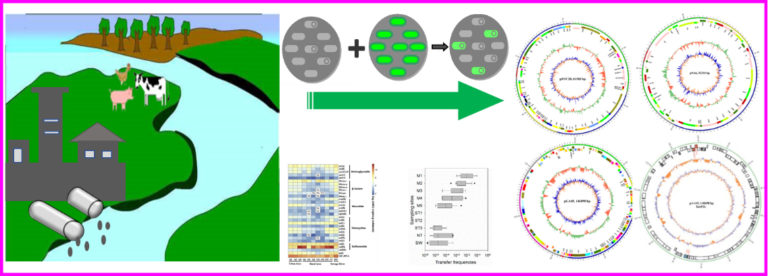
In our previous study, high levels of sulfonamide resistance genes were attributed to the selective pressure of the sulfonamide antibiotics in the Haihe River. In addition to antibiotic selective pressure, in this study, the distribution and conjugation efficiency of the multidrug-resistant conjugative plasmid in Haihe River was studied based on the recipient strain labelled with fluorescent protein. The blaIMI-3 gene was located in the ISE36 harbored by the plasmid pGA45, which is highly homologous to the sequence of E.coli W365 and plasmid PT103, indicating that the conjugative transfer of multi-resistant plasmids contributes to the dissemination and propagation of ARGs in Haihe River. Most of the isolated plasmids exhibited high transfer frequencies to the recipient strain Escherichia coli J53. Besides, a variety of the plasmid-borne ARGs were also the prevalent genes among of all the detected ARGs. This is the first study to investigate the overall distribution of conjugative plasmids which are attributable to proliferation of ARGs in a large river catchment scale. (Water Res, 2017)
-
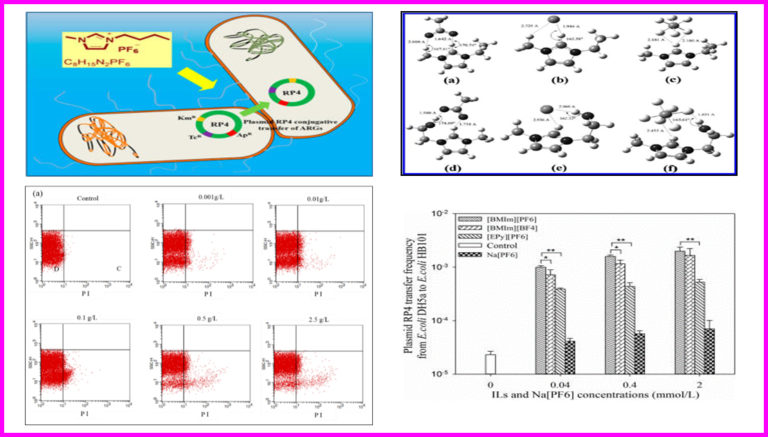
Ionic liquids (ILs), as “environmentally friendly” replacements for industrial volatile organic solvents, have been widely and recently applied in the chemical industry. However, few data have been collected regarding the toxicity and potential environmental effects of ILs, which are fairly important for preparing for their potential release into the environment. In this study, the IL 1-butyl-3-methylimidazolium hexafluorophosphate ([BMIm][PF6]) was tested for its ability to promote the proliferation and dissemination of antibiotic resistance genes (ARGs) in environmental bacteria. In freshwater microcosms, [BMIm][PF6] significantly enhanced the abundance of the sulI gene. Meanwhile, [BMIm][PF6] significantly increased the abundance of class I integrons, which play a key role in ARG dissemination. Class I integron transfer experiments between different indigenous strains of Alcaligenes sp. (SMXR) and Acinetobacter sp. (StrR) were conducted to show that the horizontal transfer frequency of class I integrons was up to 88-fold higher in the presence of IL. IL increased cell membrane permeability as evidenced by flow cytometry (FCM), thereby assisting sulI gene transfer mediated by class I integrons. This is the first report that ILs facilitate the proliferation of ARGs in environmental bacteria and thus increase risks to public health.(ES&T, 2015; Plos one, 2015)
-
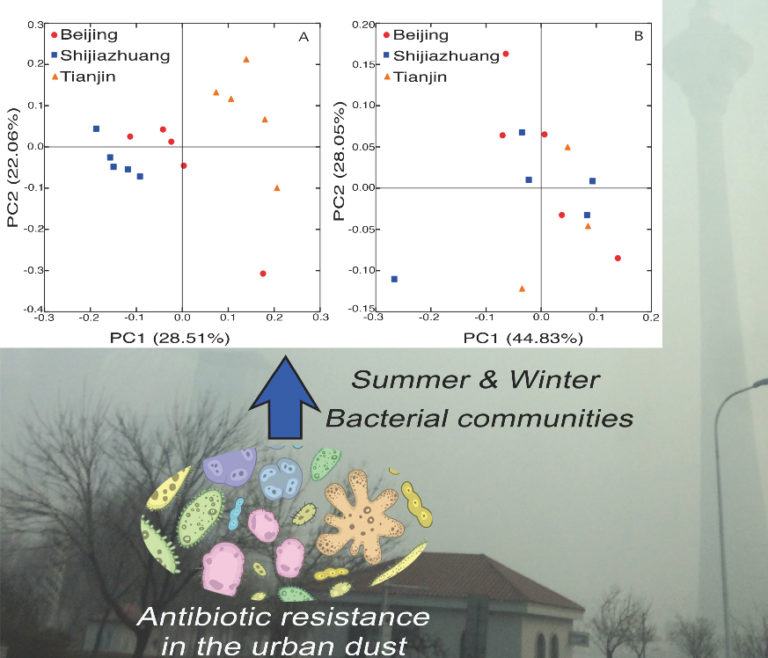
The occurrence and distribution of 20 subtypes of antibiotic resistance genes (ARGs), conferring sulfonamide, tetracycline, macrolide, β-lactam, aminoglycoside or quinolone antibiotic resistance were investigated in urban dust samples collected from the surfaces of three megacities including Beijing, Tianjin, and Shijiazhuang of Northern China. A total of 80 antibiotic-resistant bacteria (ARB) were isolated and identified, and among which 12 species were identified as opportunistic pathogens. An isolated pathogen Acinetobacter sp. was proven able to transfer antibiotic resistance, which highlights the potential risk of urban dust-associated ARG poses to public health. Deep 16S rRNA sequencing indicated high heterogeneity of bacterial communities among cities in the summer, but great homogeneity in winter. In the summer, Enterococcus, Massilia and Anthrobacter were the most prevalent genus in Tianjin, Beijing and Shijiazhuang, respectively. However, the most prevalent bacteria genera were Bacillus and Lactococcus in the winter. This is the first study of the occurrence and distribution of urban dust-associated bacterial community and its associated bacterial antibiotic resistance in Northern China. This study highlights the risk of dust-associated antibiotic resistance that threatens public health.(Environ.Sci.Technol.Lett, 2018)